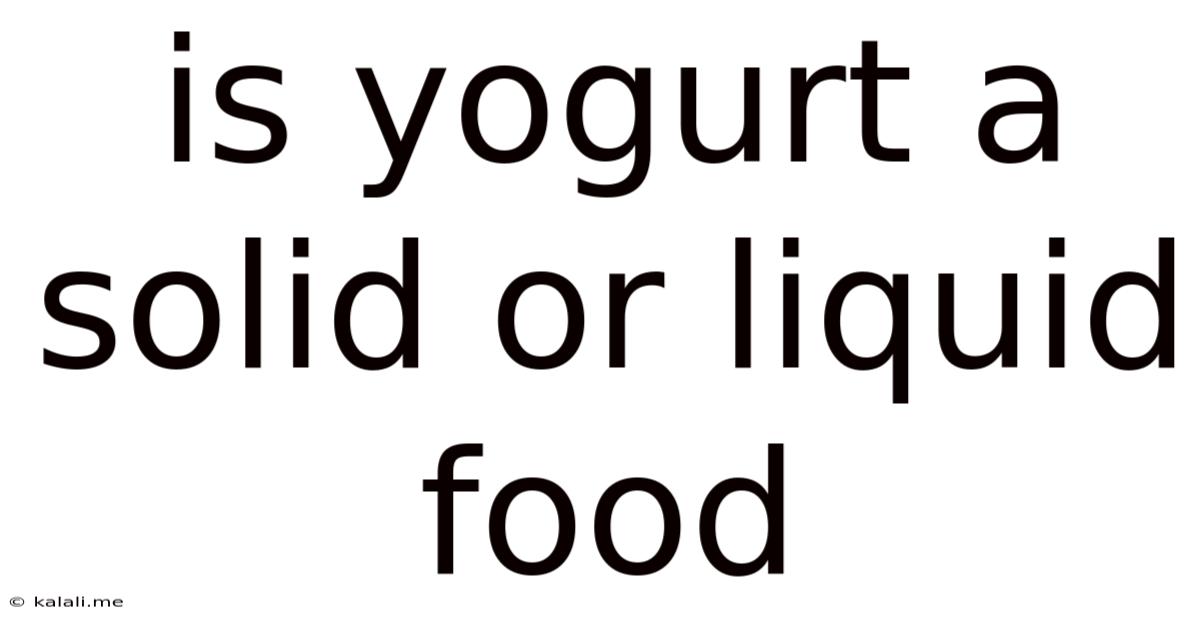Is Yogurt A Solid Or Liquid Food
Kalali
Jun 11, 2025 · 2 min read

Table of Contents
Is Yogurt a Solid or Liquid Food? A Surprisingly Complex Question
Yogurt's classification as a solid or liquid is surprisingly complex, defying a simple yes or no answer. It’s a matter of perspective and the scientific properties we consider. This article delves into the fascinating physical properties of yogurt to help you understand its ambiguous nature. This isn't just about simple categorization; understanding yogurt's rheology (the study of its flow and deformation) opens up a world of culinary and scientific understanding.
Yogurt, a fermented dairy product, possesses characteristics that blur the lines between solid and liquid. It's neither a perfectly flowing liquid like water nor a rigid solid like a rock. Instead, it sits somewhere in between, a fascinating example of a colloidal system.
Understanding Yogurt's Composition
To understand yogurt's classification, we need to examine its components. Yogurt is primarily composed of water, milk proteins (casein and whey), and fat globules. The fermentation process, using bacteria like Lactobacillus bulgaricus and Streptococcus thermophilus, converts lactose (milk sugar) into lactic acid. This acidification causes the milk proteins to coagulate, creating a thickened, gel-like structure.
The viscosity, or thickness, of yogurt varies significantly depending on several factors:
- Fat content: Higher fat content leads to a thicker, creamier yogurt.
- Protein content: Higher protein content also results in increased viscosity.
- Strain of bacteria: Different bacterial strains produce varying amounts of lactic acid, influencing the final texture.
- Processing techniques: Methods like homogenization and heat treatment affect the protein structure and, consequently, the yogurt's consistency.
Why It's Not Simply a Solid or Liquid
The complexity arises from yogurt's rheological behavior. While it holds its shape in a container, it also flows, albeit slowly, when poured or stirred. This behavior is characteristic of a non-Newtonian fluid, which means its viscosity changes under stress. The more force applied (e.g., stirring), the less viscous it becomes. This is why yogurt can be easily spread but maintains its shape when left undisturbed.
Considering Different Perspectives
From a culinary standpoint, yogurt is often treated as a semi-solid. We spoon it, spread it, and use it as an ingredient in dishes that require a solid or semi-solid base.
From a scientific standpoint, yogurt is classified as a complex fluid or colloid, a mixture of solid particles (proteins and fat) dispersed in a liquid (water). This complex structure accounts for its unique rheological properties.
The Bottom Line
Ultimately, the question of whether yogurt is a solid or liquid depends on your perspective and the criteria used for classification. It’s a multifaceted food with properties that overlap both categories. Its colloidal nature and non-Newtonian fluid behavior make it a fascinating subject for further exploration, blurring the lines of traditional food categorization. Therefore, instead of forcing a definitive answer, appreciating its unique characteristics as a complex food system is far more informative and enriching.
Latest Posts
Latest Posts
-
How Many Quarters Are In 20 Dollars
Jul 01, 2025
-
How Many 1 3 Cups Equal A Cup
Jul 01, 2025
-
How Many Hours Are In Two Years
Jul 01, 2025
-
Did You Hear About The Antelope Who Was Getting Dressed
Jul 01, 2025
-
How Many Units Are In 1 Ml
Jul 01, 2025
Related Post
Thank you for visiting our website which covers about Is Yogurt A Solid Or Liquid Food . We hope the information provided has been useful to you. Feel free to contact us if you have any questions or need further assistance. See you next time and don't miss to bookmark.